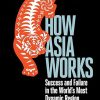How Asia Works: Success and Failure in the World’s Most Dynamic Region
£9.30£10.40 (-11%)
Until the catastrophic economic crisis of the late 1990s, East Asia was perceived as a monolithic success story. But heady economic growth rates masked the most divided continent in the world – one half the most extraordinary developmental success story ever seen, the other half a paper tiger.
Joe Studwell explores how policies ridiculed by economists created titans in Japan, Korea and Taiwan, and are now behind the rise of China, while the best advice the West could offer sold its allies in South-East Asia down the economic river. The first book to offer an Asia-wide deconstruction of success and failure in economic development, Studwell’s latest work is provocative and iconoclastic – and sobering reading for most of the world’s developing countries. How Asia Works is a must-read book that packs powerful insights about the world’s most misunderstood continent.
Read more
Additional information
| Publisher | Main edition (2 Jan. 2014), Profile Books |
|---|---|
| Language | English |
| Paperback | 352 pages |
| ISBN-10 | 9781846682438 |
| ISBN-13 | 978-1846682438 |
| Dimensions | 12.4 x 1.8 x 19.4 cm |










by Amina Ado
In all it was a very interesting read, a book policy makers in Nigeria and other African and developing countries ought to read.
When you read books like this you marvel first at the amount of work that went into putting together such a treatise and then secondly at the intellectual discipline and rigour required to arrive at such a coherent and insightful conclusion considering all the material that had to be sifted through and made a sense of. Kudos therefore to Studwell for this well researched expose on how Asia works.
The book confirmed something, which I was hoping, would not be exactly so fundamental, that is that the quality of government policies matter in extricating most countries from the stranglehold of poverty. Japan, Korea, Taiwan and China all had governments that were deeply committed in moving their countries forward, lifting a vast majority of the population from poverty and governments that pursued policies that fostered long term development goals of the countries. All these 4 countries first intervened to maximize agricultural output, then directed investments and entrepreneurs towards manufacturing and finally pushed the financial sector to focus on these areas. Though with varying degrees of success, all these countries experienced growth and vast numbers of their citizens were lifted out of poverty.
As Bill Gates asked in his review of the book, can these interventions to maximize agricultural output, export targeted manufacturing and a financial sector focused on these areas, be implemented in Africa where rapid development is urgently needed? It is probably possible but will require a lot of hard work, planning and deep thinking, and will take time and patience for things to work out even if implemented. The alternative though is further escalation of extreme poverty and the cycle of violence that often goes with it.
A great and insightful read. Highly recommended.
by Amazon Customer
This author masterfully analyses the key factors of success for the recently industrialised East Asian economies. As well as emphasising the importance of developmental states and international trade he (correctly) emphasises the important of some often neglected elements:
1. Land reform (e.g. land to the tillers).
2. Export discipline (e.g. kicking losers rather than picking winners).
3. Financial repression (e.g. the importance of regulated financial systems).
Anyone who really wants to understand what turns a poor country into a prosperous and powerful one should definitely read this book and commit its lessons to heart.
by AK
The book covers the economic development of both North-East and South-East Asian economies in the 20th and early 21st centuries in a compare and contrast fashion, in order to create a better understanding why some made giant leaps in development, while others made gains altogether far less impressive, largely irrespective of their starting levels.
The author is a staunch defender of state guided industrial policy – a view not particularly popular with neo-liberal economists, which nevertheless does a much better job of explaining the success of economic catching up to the developed world than any alternative explanation offered in the classical economics literature.
The main thrust is a three phase explanation model, namely agricultural land redistribution towards small scale yield intensive agriculture, an export driven manufacturing development, and finally a financial system geared towards supporting these two goals.
Covered examples, where these steps have been effectively followed followed and are presented in detail, are Japan (from the Meiji restoration onwards), South Korea, Taiwan and China. On the other hand, there are cases of South East Asian economies, which decided to liberalize their economies sooner – in the author’s opinion prematurely – and were thereby not capable of following the three policies effectively. These include the outright dire example of the Philippines, the moderately better one of Thailand and the best of the lot – Malaysia – which still lags significantly behind the successes of the North-East model countries.
Before the author is labelled a big government supporter, or a ‘statist’ in the widest sense, he makes a clear distinction between the needs of the catching up / development phase (where even currently free market supporters such as the UK and the US used the same mechanisms in their early development phases) and the later phase, when the first world level has been achieved. In the latter case, many of the tools needed for success in the catch-up phase become hindrances to further development and further reforms become necessary, something that some countries managed better (South Korea) than others (Japan or Taiwan).
The analysis is brilliant, the case studies very compelling, and crucially, the framework does an excellent job of describing and predicting the developmental success. The comparison between different policy choices in both the successful and less successful groups give the reader further insight and provide a more differentiated picture of what is important for development and what not.
Furthermore, the framework also wonderfully explains why industrial policy worked in North-East Asia, and less well in other regions where it has been applied (such as SE Asia, the Soviet Union, or Latin America), showing which levers have a real positive impact, which are highly detrimental to development, and which are of no real consequence. This is not about creating protected state champions but much more about relentless pruning of the low performers, first through export discipline and subsequently also at home.
If you look at it from the perspective of a manager / owner of an individual company, you may well wish for governments not following the advice, since they may well force you to earn your money in a more difficult fashion than is strictly necessary. Especially export led growth, leading both to a knowledge build-up and a quality requirement through free competition on world markets (while being protected at home) will in the short run be much more laborious than investing in gambling, tourism or real estate but is a proven method of improving the well-being of the country as a whole, rather than the wealth of an individual or profitability of a single company. As long as the government leaves little leeway for circumventing its aims, while at the same time allowing the entrepreneurs to generate adequate profits while serving the developmental needs, a win-win can be produced.
Even if not all managers would like the lessons applied by the government of the country where they operate, there are excellent learnings for them, as there are for politicians. Many of the lessons can be applied in a business set-up, too – if you are looking at expansion into new markets or product areas, or trying to catch up with more dominant competitors.
The book is perhaps not something for the very casual reader, as it takes some effort, and is written from an expert’s point of view (even if the writing is far from ponderous). If you are looking for an easier but less profound read, Kaplan’s
Asia’s Cauldron: The South China Sea and the End of a Stable Pacific
is probably the better start. If the topic is of serious interest, not reading this book would be an unfortunate omission, though.
by G.C.
Joe Studwell’s How Asia Works is fascinating reading. It talks about how Korea, Japan and China have grown while their counterparts haven’t. Studwell highlights a number of factors that contribute to economic growth:
With an agrian economy, a market garden approach to agriculture rather than farming at scale delivers the best results. But only if rent seeking interests are removed through effective agricultural reform
Industry requires total mastery of technology – which is the reason why low grade heavy industry is the starting point
Exports planned into industrial development from the beginning and a continued relentless focus on exports is required
Governments are best at keeping businesses focused on total technology mastery, raising cheap finance and weeding out failures that might be a resource suck
Studwell critiques how different countries throughout Asia have managed to process in this manner including both the strengths and the weaknesses of their respective approaches.
It was fascinating to read how Taiwan managed to succeed in spite of nationalised industries and the challenges in China’s agricultural model. How General Park ‘motivated’ Korean chaebols and the tragedy of development in Thailand, Malaysia and the Philippines.